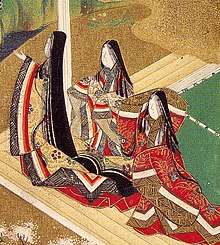Tabi
Tabi (足袋) are traditional Japanese socks worn with thonged footwear dating back to the 15th century.

Use
Tabi are worn by both men and women with footwear such as zōri and sometimes geta. Tabi must be worn with clothing such as kimono. Tabi are toe-divided, so they can be worn with thonged footwear easier.
Samurai used to wear tabi.
Styles
The most common color of tabi is white. White tabi are worn in formal situations such as tea ceremonies. Men sometimes will wear blue or black tabi for traveling. Colored tabi are available.
Traditionally, tabi are sewn from cloth cut to form. They are open at the back to be slipped on and have fasteners along the opening so it can be closed.
Jika-tabi
There is a type of tabi called jika-tabi (地下足袋, tabi that contact the ground). Made of heavier, tougher material and often having rubber soles, jika-tabi resemble boots and are outer footwear rather than socks. Like other tabi, jika-tabi are toe-divided.
Modern versions
Contemporary tabi socks—socks with a separation between the big toe and its neighbor to allow wear with thonged footwear—are also available. This reflects the number of people who still prefer to wear zōri and geta, especially during Japan's hot, humid summers.
Sometimes, modern tabi have elastic openings instead of fasteners.
A related item are toe socks, which have five separate compartments; these are called gohon-yubi no kutsushita (5本指の靴下, five-toe socks) in Japanese.
Gallery
 Illustration of tabi
Illustration of tabi- Woman wearing tabi
 A pair of tabi
A pair of tabi

